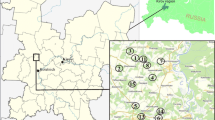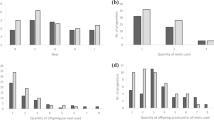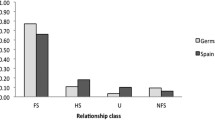Abstract
We established pedigree relations in three wild common marmoset social groups for which observational data were available, together with genotypes of some individuals from neighboring groups. Relatedness of 40 individuals were based on 11 microsatellite loci amplified from nDNA obtained noninvasively from plucked hair. The wild marmosets were only half as variable as a captive population characterized previously: 2–6 alleles/locus; HO = 0.41 and HE = 0.35. Parentage exclusion probabilities were 61.8% for an offspring and one alleged parent and 90.7% for an offspring with one confirmed and one alleged parent. Each group (n = 5–14 individuals) had two breeding females and ≥2 adult males. Within each group the infants and reproductively inactive adults were closely related to at least the breeding females; the latter were related to each other as closely as mother/infant pairs or sisters. Relatedness of adult males was lower, indicating recent intergroup dispersal. Genetic data confirm Callithrix jacchus live in relatively stable extended family groups of closely related individuals. Matings occurred preferentially among the least related adults and most infants were fathered by the dominant male. The genetic data are consistent with polygynmonandry as are the field observations. Callithrix have variable mating systems, ranging from monogamy to polyandry to polygyny within social groups plus extragroup copulations; our data provide no evidence for polyandry and are inconclusive with respect to extragroup paternity. Nevertheless, noninvasive multilocus genotyping methods will resolve these questions when longer-term studies of entire populations are undertaken.
Similar content being viewed by others
REFERENCES
Abbott, D. H. (1984). Behavioral and physiological suppression of fertility in subordinate marmoset monkeys. Am. J. Primatol. 6: 169-186.
Altmann, J., Alberts, S. C., Haines, S. A., Dubach, J., Muruthi, P., Geffen, E., Cheesman, D., Mututua, R., Saiyalel, S., Wayne, R., Lacy, R., and Bruford, M. (1996). Behavior predicts genetic structure in a wild primate group. Proc. Natl. Acad. Sci. USA. 93: 5797-5801.
Benirschke, K., Anderson, J. M., and Brownhill, L. E. (1962). Marrow chimerism in marmosets. Science 138: 513-515.
Berard, J. D., Nürnberg, P., Epplen, J. T., and Schmidtke, J. (1993). Male rank, reproductive behavior, and reproductive success in free-ranging rhesus macaques. Primates 34: 481-489.
Digby, L. J. (1994). Social Organization and Reproductive Strategies in a Wild Population of Common Marmosets (Callithrix jacchus), Ph.D. thesis, University of California, Davis.
Digby, L. J. (1995). Social organization in a wild population of Callithrix jacchus: II. Intragroup social behavior. Primates 36: 361-375.
Digby, L. J. (1999). Sexual behavior and extra-group copulations in a wild population of common marmosets (Callithrix jacchus). Folia Primatol. 70: 136-145.
Digby, L. J., and Barreto, C. E. (1993). Social organization in a wild population of Callithrix jacchus: I. Group composition and dynamics. Folia Primatol. 61: 123-134.
Digby, L. J., and Ferrari, S. F. (1994). Multiple breeding females in free-ranging groups of Callithrix jacchus. Int. J. Primatol. 15: 389-397.
Dixson, A. F., Anzenberger, G., Monteiro Da Cruz, M. A. O., Patel, I., and Jeffreys, A. J. (1992). DNA fingerprinting of free-ranging groups of common marmosets (Callithrix jacchus jacchus) in N.E. Brazil. In Martin, R. D., Dixson, A. F., and Wickings, E. J. (eds.), Paternity in Primates: Genetic Tests and Theories, Karger, Basel, pp. 192-202.
Dixson, A. F., Hastie, N., Patel, I., and Jeffreys, A. J. (1988). DNA ''fingerprinting'' of captive family groups of common marmosets (Callithrix jacchus). Folia Primatol. 51: 52-55.
Faulkes, C. G., Arruda, M. F., and Monteiro da Cruz, M. A. O. (1996). Mitochondrial DNA control region sequence divergence within and between wild populations of the common marmoset, Callithrix jacchus. XVIth Congress of the International Primatological Society, XIXth Conference of the American Society of Primatologists, University of Wisconsin, Madison. Abstracts.
Ferrari, S. F., and Diego, V. H. (1992). Long-term changes in a wild marmoset group. Folia Primatol. 58: 215-218.
Ferrari, S. F., and Digby, L. J. (1996). Wild Callithrix groups: Stable extended families? Am. J. Primatol. 38: 19-27.
Ferrari, S. F., and Lopes Ferrari, M. A. (1989). A reevaluation of the social organisation of the Callitrichidae, with reference to the ecological differences between genera. Folia Primatol. 52: 132-147.
Gagneux, P., Boesch, C., and Woodruff, D. S. (1997). Microsatellite scoring errors associated with noninvasive genotyping based on nuclear DNA amplified from shed hair. Mol. Ecol. 6: 861-868.
Gagneux, P., Boesch, C., and Woodruff, D. S. (1999). Female reproductive strategies, paternity, and community structure in wild West African chimpanzees. Anim. Behav. 57: 19-32.
Goldizen, A. W. (1987). Tamarins and marmosets: communal care of offspring. In Smuts, B., Cheney, D., Seyfarth, R., Wrangham, R., and Struhsaker, T. (eds.), Primate Societies, University of Chicago, Chicago, pp. 34-43.
Goldizen, A. W. (1988). Tamarin and marmoset mating systems: Unusual flexibility. Trends Ecol. Evol. 3: 36-40.
Hashimoto, C., Furuichi, T., and Takenaka, O. (1996). Matrilineal kin relationship and social behavior of wild bonobos (Pan paniscus): Sequencing the D-loop region of mitochondrial DNA. Primates 37: 305-318.
Jamieson, A., and Taylor, S. C. S. (1997). Comparisons of three probability formulae for parentage exclusion. Anim. Gen. 28: 397-400.
Marshall, T. C., Slate, J., Kruuk, L. E. B., and Pemberton, J. M. (1998). Statistical confidence for likelihood-based paternity interference in natural populations. Mol. Ecol. 7: 639-655.
Martin, R. D., Dixson, A. F., and Wickings, E. J. (eds.) (1992). Paternity in Primates: Genetic Tests and Theories, S. Karger, Basel.
Meireles, C. M. M., Sampaio, M. I. C., Schneider, H., and Schneider, M. P. C. (1992). Protein variation, taxonomy and differentiation in five species of marmosets. Primates 33: 227-238.
Morin, P. A., Wallis, J., Moore, J. J., and Woodruff, D. S. (1994). Paternity exclusion in a community of wild chimpanzees. Mol. Ecol. 3: 469-478.
Mundy, N. I., and Woodruff, D. S. (1996). Polymorphic microsatellite markers in the loggerhead shrike (Lanius ludovicianus) isolated from a library enriched for CA repeats. Mol. Ecol. 5: 811-813.
Nievergelt, C. M., Mundy, N. I., and Woodruff, D. S. (1998). Microsatellite primers for genotyping common marmosets (Callithrix jacchus) and other callitrichids. Mol. Ecol. 7: 1431-1439.
Nürnberg, P., Sauermann, U., Kayser, M., Lanfer, C., Manz, E., Widdig, A., Berard, J., Bercovitch, F. B., Kessler, M., Schmidtke, J., and Krawczak, M. (1998). Paternity assessment in rhesus macaques (Macaca mulatta): Multilocus DNA fingerprinting and PCR marker typing. Am. J. Primatol. 44: 1-18.
Ohsawa, H., Inoue, M., and Takenaka, O. (1993). Mating strategy and reproductive success of male patas monkeys (Erythrocebus patas). Primates 34: 533-544.
Pope, T. R. (1990). The reproductive consequences of male cooperation in the red howler monkey: Paternity exclusion in multi-male and single-male troops using genetic markers. Behav. Ecol. Sociobiol. 27: 439-446.
Pope, T. R. (1996). Socioecology, population fragmentation, and patterns of genetic loss in endangered primates. In Avise, J. C., and Hamrick, J. L. (eds.), Conservation Genetics: Case Histories from Nature, Chapman and Hall, New York, pp. 119-159.
Price, E. C. (1991). Stability of wild callitrichid groups. Folia Primatol. 57: 111-114.
Queller, D. C., and Goodnight, K. F. (1989). Estimating relatedness using genetic markers. Evolution 43: 258-275.
Rothe, H., and König, A. (1991). Variability of social organization in captive common marmosets (Callithrix jacchus). Folia Primatol. 57: 28-33.
Rylands, A. B. (1982). TheBehaviour and Ecology of Three Species of Marmosets and Tamarins (Callitrichidae, Primates) in Brazil, Ph.D. thesis, University of Cambridge.
Rylands, A. B. (1986). Infant-carrying in a wild marmoset group, Callithrix humeralifer: Evidence for a polyandrous mating system. In de Mello, M. T. (ed.), A primatologia no Brasil-2, Sociedade Brasileira de Primatologia, Brasilia, pp. 131-144.
Rylands, A. B. (1996). Habitat and the evolution of social and reproductive behaviour in Callitrichidae. Am. J. Primatol. 38: 5-18.
Saltzman, W., Severin, J. M., Schultz-Draken, N. J., and Abbott, D. H. (1997). Behavioral and social correlates of escape from suppression of ovulation in female common marmosets housed with the natal family. Am. J. Primatol. 41: 1-21.
Santee, D. P., and Arruda, M. F. (1994). The NISIA floresta common marmoset research station. Neotrop. Prim. 2: 8-11.
Scanlon, C. E., Chalmers, N. R., and Monteiro da Cruz, M. A. O. (1988). Changes in the size, composition, and reproductive condition of wild marmoset groups (Callithrix jacchus jacchus) in North East Brazil. Primates 29: 295-305.
Sussman, R. W., and Garber, P. A. (1987). A new interpretation of the social organization and mating system of the Callitrichidae. Int. J. Primatol. 8: 73-92.
Taberlet, P., Waits, L. P., and Luikart, G. (1999). Noninvasive genetic sampling: Look before you leap. Trends Ecol. Evol. 14: 323-327.
Tardif, S. D., Harrison, M. L., and Simek, M. A. (1993). Communal infant care in marmosets and tamarins: Relation to energetics, ecology, and social organization. In Rylands, A. B. (ed.), Marmosets and Tamarins: Systematics, Behaviour, and Ecology, Oxford University Press, Oxford, pp. 220-234.
Watkins, D. I., Garber, T. L., Chen, Z. W., Hughes, A. L., and Levins, N. L. (1991). Evolution of New World primate MHC class I genes. In Klein, J., and Klein, D. (eds.), Molecular Evolution of the Major Histocompatibility Complex, Springer-Verlag, Heidelberg, pp. 177-191.
Woodruff, D. S. (1990). Genetics and demography in the conservation of biodiversity. J. Sci. Soc. Thailand 16: 117-132.
Woodruff, D. S. (1993). Noninvasive genotyping of primates. Primates 34: 333-346.
Author information
Authors and Affiliations
Rights and permissions
About this article
Cite this article
Nievergelt, C.M., Digby, L.J., Ramakrishnan, U. et al. Genetic Analysis of Group Composition and Breeding System in a Wild Common Marmoset (Callithrix jacchus) Population. International Journal of Primatology 21, 1–20 (2000). https://doi.org/10.1023/A:1005411227810
Issue Date:
DOI: https://doi.org/10.1023/A:1005411227810




